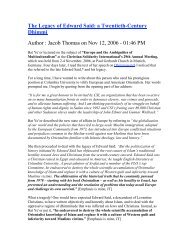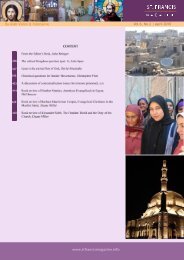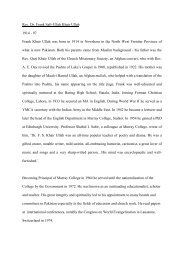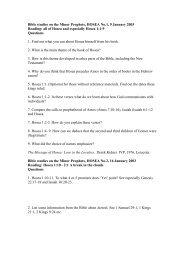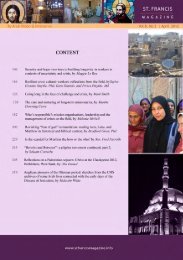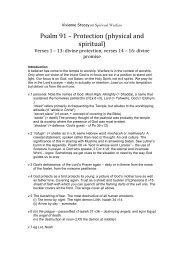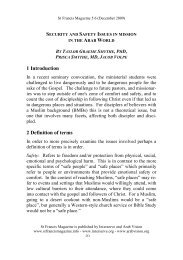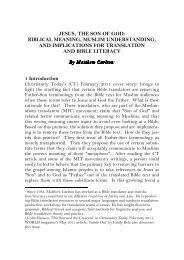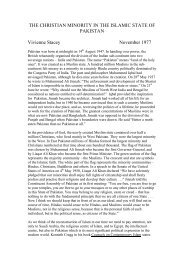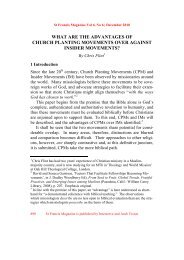Download the pdf - St.Francis Magazine
Download the pdf - St.Francis Magazine
Download the pdf - St.Francis Magazine
You also want an ePaper? Increase the reach of your titles
YUMPU automatically turns print PDFs into web optimized ePapers that Google loves.
<strong>St</strong> <strong>Francis</strong> <strong>Magazine</strong> Vol 9, No 4 | August 2013<br />
‘messages’ by Khouri and a discussion panel of three Egyptian Christians. Shafir would often have an<br />
interview with a North African Christian. 147<br />
The unmistakable Middle Eastern atmosphere of <strong>the</strong>se programs, with presenters from Lebanon<br />
and Syria, and sometimes a panel of Egyptians, was not <strong>the</strong> best choice for a program aimed at North<br />
Africa. This impacted <strong>the</strong> extent to which <strong>the</strong> programs could speak to <strong>the</strong> audience in its context.<br />
For <strong>the</strong> listeners, <strong>the</strong>se non-North Africans were foreigners. In spite of this, NAM could write, in<br />
1985, that individuals ‘all over North Africa – some who have never met a Christian believer – have<br />
trusted Christ as a result of <strong>the</strong> Light upon Light broadcast. Several of <strong>the</strong> church leaders of North<br />
Africa were first drawn to <strong>the</strong> Gospel by <strong>the</strong> [Light upon Light] program. [And] we are convinced<br />
<strong>the</strong>re are many o<strong>the</strong>rs who have not written us about <strong>the</strong>ir faith.’ 148<br />
When RSB decided to broadcast over ELWA again, by <strong>the</strong> late 1980s, it decided to create<br />
worship programs for those unable to have communion with o<strong>the</strong>r believers. This program was to<br />
contain hymns, prayers and Bible readings. RSB was working on two pilot programs of 15 minutes<br />
and two of 30 minutes for evaluation purposes. These programs were done in MSA and colloquial<br />
Arabic. The first worship program broadcast by ELWA was on 26 December 1988. This was a<br />
30-minute weekly program in classical and colloquial North African Arabic. 149 This project was cut<br />
short by <strong>the</strong> destruction of ELWA in 1990. 150<br />
Sīkālī’s program Let’s Walk Toge<strong>the</strong>r used several different people in each program with a<br />
linguistic mixture of MSA and colloquial, and a rotation of presenters. The broad goal of <strong>the</strong><br />
programs was to change <strong>the</strong> listener’s negative attitude towards Christianity and to encourage <strong>the</strong><br />
listener to correspond with RSB and to engage in BCC’s. The program was not ‘preachy’, but had a<br />
‘low key’ approach. 151<br />
Path of Life, <strong>the</strong> programs RSB produced since 1996, maintained <strong>the</strong> target audience and <strong>the</strong><br />
program format of Let’s Walk Toge<strong>the</strong>r. Its aim continued to be ‘to attract Muslim listeners who<br />
are not yet ready for extended Bible exposition. The programme is designed to interest <strong>the</strong>m in <strong>the</strong><br />
person of Christ and allow <strong>the</strong>m to discover that <strong>the</strong> Bible offers true and satisfying solutions to <strong>the</strong><br />
problems that trouble <strong>the</strong>m’, RSB reported. The Sīkālīs continued presenting <strong>the</strong> programs. 152<br />
While NAM’s radio program format and name have changed several times since 1965, <strong>the</strong><br />
purpose and intent remained largely <strong>the</strong> same. That was, ‘to present listeners with a Biblical view of<br />
life so as to make following Christ a viable and understandable option for <strong>the</strong>ir lives’. 153<br />
This ‘Biblical view of life’ of NAM and later of AWM did not entail <strong>the</strong> idea that <strong>the</strong> gospel had a<br />
socio-political component, as in all of its programs RSB focused on <strong>the</strong> individual, his relationship<br />
with God, and on micro-ethics. Therefore, in its programs, RSB did not address important parts of<br />
<strong>the</strong> context of <strong>the</strong> people <strong>the</strong>y were speaking to. This meant RSB was silent about an important part<br />
of <strong>the</strong> gospel, but also about a relevant part of <strong>the</strong> context of <strong>the</strong> audience.<br />
147 Harris and Sikaly, ‘What’s Happening in 1980’ p. 5.<br />
148 ‘Airwaves for North Africa’, in NAM-Media (Autumn 1985), p. 1.<br />
149 ‘News in Brief’, in Contact (November 1988), p. 1.<br />
150 ‘Electronic Worship for <strong>the</strong> Arab World’, p. 1.<br />
151 ‘New Arabic Broadcasting!’ in Contact (September 1990), p. 1.<br />
152 ‘Path of Life’, in Contact (April 1996), p. 2. ‘A Modern Nicodemus’, in Contact (February 1997), p. 1.<br />
153 ‘Walking Toge<strong>the</strong>r’, in Contact (February 1995), p. 2.<br />
<strong>St</strong> <strong>Francis</strong> <strong>Magazine</strong> is published by Arab Vision and Interserve 21


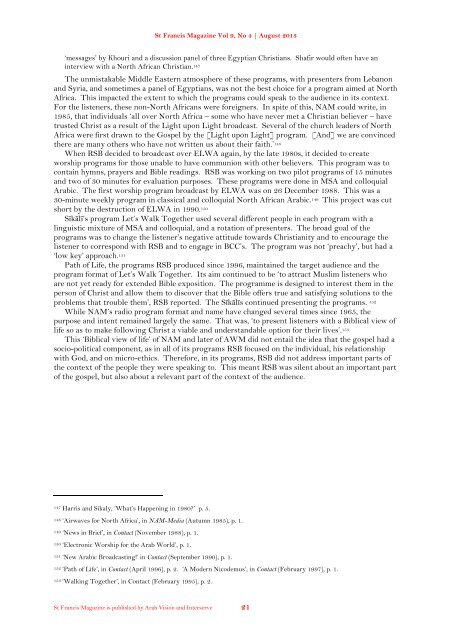

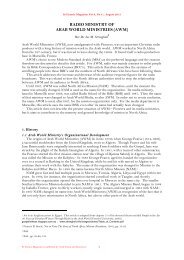
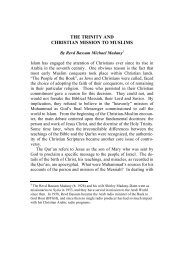
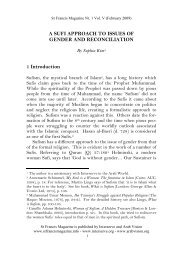
![Reflections on Surah Fatiha and the Lord's Prayer[1] - St.Francis ...](https://img.yumpu.com/49377951/1/184x260/reflections-on-surah-fatiha-and-the-lords-prayer1-stfrancis-.jpg?quality=85)
